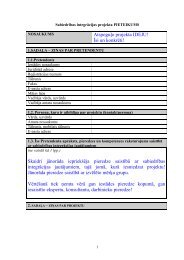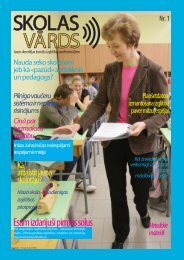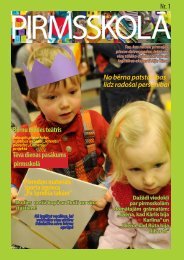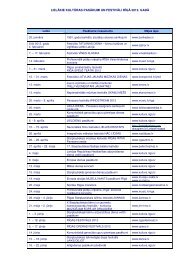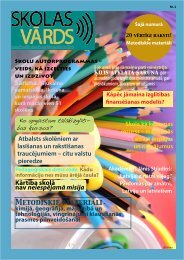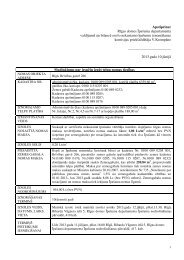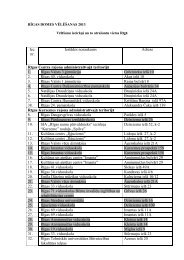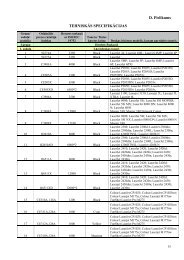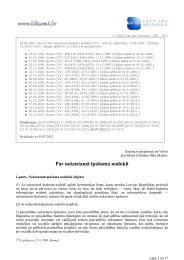Riga - European Capital of Culture 2014 candidate
Riga - European Capital of Culture 2014 candidate
Riga - European Capital of Culture 2014 candidate
- No tags were found...
Create successful ePaper yourself
Turn your PDF publications into a flip-book with our unique Google optimized e-Paper software.
1514, becoming the pastor <strong>of</strong> the congregation in Limbaži. TheCzech translator Pavel Stoll discovered that some <strong>of</strong> the songsRamm is renowned for translating were written by Jan Hus. TheMoravian Brethren movement that would be hugely influentialamong Latvians in 18 th century southern Livonia (now Latvia) wasinspired by Hus. The book Christi ab incarnationis by Jan Huswas printed in 1514 by Weissenburger in Landshut. Also in 1514,the manuscript <strong>of</strong> Дзесяціглаў was completed; Frantsisk Skarina,born in Vitebsk and acquainted with <strong>Riga</strong> Baltic Germans, wouldpublish it in Vilnius in 1522.A few hundred publications from 1514 are held in the collections<strong>of</strong> national and university libraries. The Latvian National Librarymaintains close contact with the keepers <strong>of</strong> these rare volumes.The library <strong>of</strong> the Duke <strong>of</strong> Courland, for example, is currently inthe National Library <strong>of</strong> Finland and was formerly at the University<strong>of</strong> Helsinki. The Latvian National Library intends to locate othercopies <strong>of</strong> works published in or connected to 1514, appropriate tothe exhibition in the new library building in <strong>2014</strong>. The exhibition willalso tell <strong>of</strong> other ancient libraries that existed five centuries ago.There is no doubt that <strong>2014</strong> will see the publication <strong>of</strong> a host <strong>of</strong>books across the globe – many more than were printed in 1514!In cooperation with the finest publishing houses in Europe, an exhibition<strong>of</strong> the best books, atlases and albums printed in <strong>2014</strong> isalso being planned.Bitwa pod Orsząin Basel, Henri Estienne (1460?—1520) printed Arithmetica decemlibris demonstrata in Paris, Wynkyn de Worde worked in London. Itwas in 1514 that Aldus Manutius introduced the use <strong>of</strong> blue paper.The first book in Arabic letters was printed by the brothers DeGregori Fano in Italy, and Erhard Oeglin produced the firstHebrew typesetting in Augsburg in this year. A Torah was printedin Constantinople, and Ottaviano dei Petrucci completed the publication<strong>of</strong> the eleventh series <strong>of</strong> scores in Venice. 1514 also sawthe introduction <strong>of</strong> “+“ and “–“ signs.It is also held that the first book printed in Polish appeared in 1514rather than 1515 as commonly believed. Soon after victory overthe Russians at Smolensk, a letter <strong>of</strong> Sigismund I to Pope Leo Xwas published.With regard to <strong>Riga</strong>, it should be noted that this is the year theprinter Joannes Badius Ascenius produces the “Danish Chronicle“<strong>of</strong> Saxo Grammaticus (c. 1150-1220). This history <strong>of</strong> Denmark isone <strong>of</strong> the most important sources on the early history <strong>of</strong> what isnow Latvia. The “Saga <strong>of</strong> Hadingus“ tells <strong>of</strong> a Danish Viking andhis blood brother, who make war upon the Couronian chieftainLoker. The Couronian leader defeats them and captures them.Escaping, Hadingus craftily seizes a city on the Daugava, takingits chieftain hostage and asking for the chieftain’s ransom in gold.In the Saga <strong>of</strong> Frodi, raids on the Baltic region are described.The first book in Latvian is printed in 1525. The first librarywas established a year earlier. Both <strong>of</strong> these events are linkedto Nikolai Ramm, the pastor <strong>of</strong> the Latvian congregation at St.James’s Church in <strong>Riga</strong> – he arrived in what is now Latvia inThe dawn <strong>of</strong> the electronic age, digital environments and digitallibraries has led some to dub our era the Second Coming<strong>of</strong> Gutenberg. The technical environment that affects informationflow, knowledge, cultural values and the dissemination <strong>of</strong> ideashas changed as radically as it did five centuries ago. Handwrittenmanuscripts were replaced by printing, just as the computer keyboardhas shifted the world <strong>of</strong> words now. Drawing met engraving– today computer graphics <strong>of</strong> all kinds come into play. The printingpress took the place <strong>of</strong> the scriptorium – the great ‘scriptorium’today is the World Wide Web. The king, however the Content, isstill king.What: International conference and exhibition.Where: Latvian National Library.When: Exhibition throughout the year; conference in April.Concept author: Andris Vilks, Director <strong>of</strong> the Latvian NationalLibrary.Organisers: University <strong>of</strong> Latvia; Latvian National Library.Danorum Regum heroumque Historiae, Paris 151440 41



